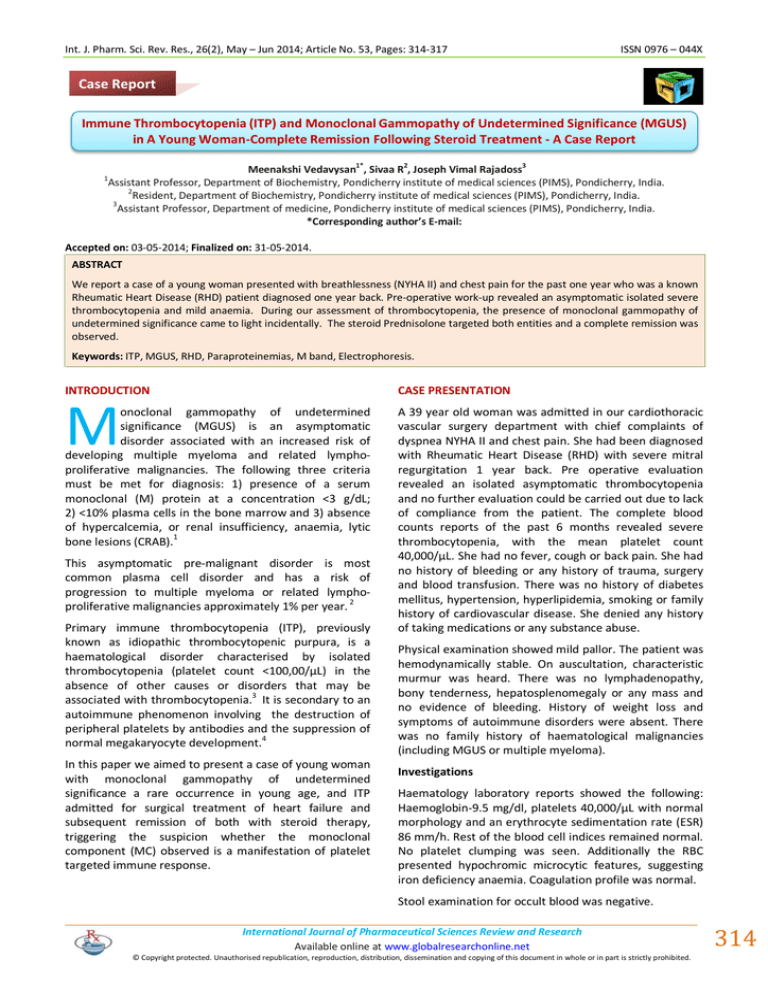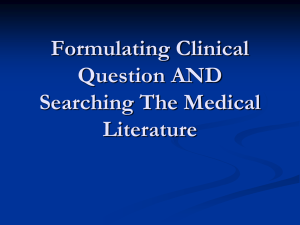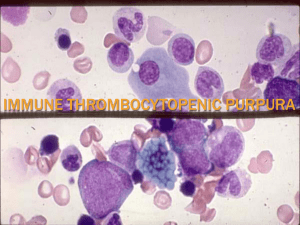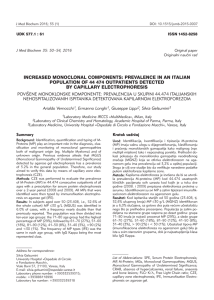Document 13309818
advertisement

Int. J. Pharm. Sci. Rev. Res., 26(2), May – Jun 2014; Article No. 53, Pages: 314-317 ISSN 0976 – 044X Case Report Immune Thrombocytopenia (ITP) and Monoclonal Gammopathy of Undetermined Significance (MGUS) in A Young Woman-Complete Remission Following Steroid Treatment - A Case Report 1* 1 2 3 Meenakshi Vedavysan , Sivaa R , Joseph Vimal Rajadoss Assistant Professor, Department of Biochemistry, Pondicherry institute of medical sciences (PIMS), Pondicherry, India. 2 Resident, Department of Biochemistry, Pondicherry institute of medical sciences (PIMS), Pondicherry, India. 3 Assistant Professor, Department of medicine, Pondicherry institute of medical sciences (PIMS), Pondicherry, India. *Corresponding author’s E-mail: Accepted on: 03-05-2014; Finalized on: 31-05-2014. ABSTRACT We report a case of a young woman presented with breathlessness (NYHA II) and chest pain for the past one year who was a known Rheumatic Heart Disease (RHD) patient diagnosed one year back. Pre-operative work-up revealed an asymptomatic isolated severe thrombocytopenia and mild anaemia. During our assessment of thrombocytopenia, the presence of monoclonal gammopathy of undetermined significance came to light incidentally. The steroid Prednisolone targeted both entities and a complete remission was observed. Keywords: ITP, MGUS, RHD, Paraproteinemias, M band, Electrophoresis. INTRODUCTION CASE PRESENTATION M onoclonal gammopathy of undetermined significance (MGUS) is an asymptomatic disorder associated with an increased risk of developing multiple myeloma and related lymphoproliferative malignancies. The following three criteria must be met for diagnosis: 1) presence of a serum monoclonal (M) protein at a concentration <3 g/dL; 2) <10% plasma cells in the bone marrow and 3) absence of hypercalcemia, or renal insufficiency, anaemia, lytic bone lesions (CRAB).1 This asymptomatic pre-malignant disorder is most common plasma cell disorder and has a risk of progression to multiple myeloma or related lymphoproliferative malignancies approximately 1% per year. 2 Primary immune thrombocytopenia (ITP), previously known as idiopathic thrombocytopenic purpura, is a haematological disorder characterised by isolated thrombocytopenia (platelet count <100,00/µL) in the absence of other causes or disorders that may be associated with thrombocytopenia.3 It is secondary to an autoimmune phenomenon involving the destruction of peripheral platelets by antibodies and the suppression of 4 normal megakaryocyte development. In this paper we aimed to present a case of young woman with monoclonal gammopathy of undetermined significance a rare occurrence in young age, and ITP admitted for surgical treatment of heart failure and subsequent remission of both with steroid therapy, triggering the suspicion whether the monoclonal component (MC) observed is a manifestation of platelet targeted immune response. A 39 year old woman was admitted in our cardiothoracic vascular surgery department with chief complaints of dyspnea NYHA II and chest pain. She had been diagnosed with Rheumatic Heart Disease (RHD) with severe mitral regurgitation 1 year back. Pre operative evaluation revealed an isolated asymptomatic thrombocytopenia and no further evaluation could be carried out due to lack of compliance from the patient. The complete blood counts reports of the past 6 months revealed severe thrombocytopenia, with the mean platelet count 40,000/µL. She had no fever, cough or back pain. She had no history of bleeding or any history of trauma, surgery and blood transfusion. There was no history of diabetes mellitus, hypertension, hyperlipidemia, smoking or family history of cardiovascular disease. She denied any history of taking medications or any substance abuse. Physical examination showed mild pallor. The patient was hemodynamically stable. On auscultation, characteristic murmur was heard. There was no lymphadenopathy, bony tenderness, hepatosplenomegaly or any mass and no evidence of bleeding. History of weight loss and symptoms of autoimmune disorders were absent. There was no family history of haematological malignancies (including MGUS or multiple myeloma). Investigations Haematology laboratory reports showed the following: Haemoglobin-9.5 mg/dl, platelets 40,000/µL with normal morphology and an erythrocyte sedimentation rate (ESR) 86 mm/h. Rest of the blood cell indices remained normal. No platelet clumping was seen. Additionally the RBC presented hypochromic microcytic features, suggesting iron deficiency anaemia. Coagulation profile was normal. Stool examination for occult blood was negative. International Journal of Pharmaceutical Sciences Review and Research Available online at www.globalresearchonline.net © Copyright protected. Unauthorised republication, reproduction, distribution, dissemination and copying of this document in whole or in part is strictly prohibited. 314 Int. J. Pharm. Sci. Rev. Res., 26(2), May – Jun 2014; Article No. 53, Pages: 314-317 Biochemistry revealed normal liver function tests except for an increased total protein of 9.1 g/dl and albumin of 4.0 g/dl. Renal function tests, serum folate, vitamin B12 and thyroid profile were normal. Serology showed a CRP value of 60mg/dl and screening for infection panel reported negative for HbsAg, HIV and HCV. With Immunology investigation, ANA and AntidsDNA antibodies were found to be negative. Antiplatelet antibody could not be done. Bone marrow biopsy and aspiration reported erythroid hyperplasia, increased megakaryocytes and mildly elevated plasma cells. Serum protein electrophoresis revealed a striking paraprotein “M” spike. The values are Albumin - 35%, α1 – 7.0%, α2 – 15%, β – 10%, γ –33% (Fig.1); M Band - 17.4 (contribute 53% of γ globulin) and myeloma protein - 1.6 g/dl. Urine for Bence Jones protein was negative. The albumin corrected serum calcium was normal. X ray chest showed cardiomegaly and ECG showed evidence of LVH strain. Complete radiographic bone survey of the skeleton, including all long bones revealed no lytic lesions. USG abdomen was normal. Figure 1: Serum protein electrophoretic pattern of the patient. Differential diagnosis It is important to distinguish MGUS from more advanced plasma cell dyscrasias for the purposes of prognosis and treatment. The main conditions to consider in the differential diagnosis of MGUS are idiopathic BenceJones proteinuria and primary amyloidosis (AL). Isolated thrombocytopenia has several possible causes including pseudo thrombocytopenia, autoimmune diseases, medications or infections. Idiopathic thrombocytopenic purpura is a diagnosis of exclusion. Viral serologies can be used to rule out common infectious aetiologies, such as hepatitis C and HIV. Autoimmune disorders can be ruled out by a thorough history and examination and measurement of autoimmune markers such as rheumatoid factor and antinuclear antibodies. Medication induced thrombocytopenia typically includes a history of a recent start of a new agent or drugs that are only taken intermittently, including over-the-counter medications, herbal remedies and quinine containing preparations. ISSN 0976 – 044X Hypersplenism due to liver disease, congenital thrombocytopenia, myelodysplasia are main causes to be excluded. Especially in women, pregnancy is to be ruled out for the possibility of gestational thrombocytopenia and preeclampsia can also cause thrombocytopenia. Treatment and follow-up In procedures such as cardiac surgery, bleeding risks and complications even from minor bleeding are quite high. Hence a platelet count greater than 80,000/µL is required 5,6 by surgeons/anaesthesiologists. She was started on steroids- prednisolone 60mg single dose per day for 2 weeks. The double valve replacement was deferred until normal platelet count returned. During the follow up after 2 weeks, the complete blood count was repeated. The platelet has bounced back to normal. The repeat serum electrophoresis surprisingly showed a normal electrophoretic pattern. Remarkably there was not even a trace of paraprotein “M” band. DISCUSSION ITP being an acquired disorder, two criteria are required in order to make this diagnosis.7,8 Isolated thrombocytopenia with normal blood cell indices and absence of clinically apparent associated conditions (eg, systemic lupus erythematosus, antiphospholipid syndrome, chronic lymphocytic leukemia, drug-induced) collectively known as "secondary immune thrombocytopenia".9 There is no gold standard test that establishes the diagnosis for ITP. The diagnosis involves exclusion of other associated conditions. Hence a detailed investigation was initiated to evaluate the cause of thrombocytopenia. We found all the red cell indices normal except haemoglobin and peripheral smear indicating iron deficiency anaemia. With no evidence of fever, infections, drug history, clinical features or lab parameters suggestive of any autoimmune disorders and pregnancy we made a probable diagnosis of ITP. Specifically ITP has a higher prevalence in women of child bearing age9 and our patient had this risk factor supporting our diagnosis. Bone marrow aspiration and biopsy are not warranted except in older patients to exclude myelodysplasia. Though, we deemed as Evans syndrome initially in the light of findings of ITP and unexplained anaemia, systematic examination revealed no evidence of hemolysis. Further bone marrow studies are carried out which demonstrated a mildly hyper cellular marrow, erythroid hyperplasia and increased megakaryocytes. With elevated total protein and ESR values, serum protein electrophoresis was ordered, which revealed a prominent M band in the gamma region. Literature review showed a significant number of case reports associating MGUS with various diseases.10-15 An exhaustive population based study launched by mayo clinic refuted many of the disease association hitherto reported and concluded them to be merely co-incidental. The diseases such as autonomic neuropathy, multiple International Journal of Pharmaceutical Sciences Review and Research Available online at www.globalresearchonline.net © Copyright protected. Unauthorised republication, reproduction, distribution, dissemination and copying of this document in whole or in part is strictly prohibited. 315 Int. J. Pharm. Sci. Rev. Res., 26(2), May – Jun 2014; Article No. 53, Pages: 314-317 myeloma, plasma cell proliferative disorders, hip and vertebral bone fractures, osteoporosis kidney transplant have been confirmed to have strong association with 16 MGUS. Merlini and Stone had reported few cases of 17 MGUS presenting with autoimmune manifestations. ITP was observed as the common manifestation in few of the cases of MGUS.18-21 A systematic study carried by Davide Rossi etal, screening MGUS patients for ITP, given an extensive account on the prevalence and clinical course 22 of ITP in a consecutive series of MGUS patients. They noticed the incidence of ITP in MGUS is more than in general adult population and patients with MGUS associated ITP were older than MGUS without ITP(Median age 73 yrs vs. 65 yrs). The patients who were treated with steroid, the ITP resolved without any change in monoclonal component (MC). There was even relapse of ITP on tapering Prednisolone warranting aggressive therapy with Cyclophosphamide and even Rituximab. There was only a partial remission of MC and in one patient the MC size increased. Their study failed to corroborate the hypothesis that the paraprotein in MGUS associated ITP may act as a platelet reactive antibody. They never suggested ITP as a cause to be differentiated and ruled out while diagnosing MGUS. There are few reports where ITP was diagnosed prior to cardiac surgery. There are reports where patients with ITP had successful mitral valve repair for severe mitral valve regurgitation.23-25 To our knowledge this is the first report of ITP associated with MGUS in a patient treated for heart failure at a young age. The first unique feature of our case is that the onset of MGUS is at a young age, as there is no data on the incidence of MGUS in a younger population aged less than 40 yrs. It is prevalent in approximately 3% of the general population aged 50 years and older with the prevalence rates higher in men than in women.26 The epidemiological data gleaned from our extensive literature survey revealed the median age of diagnosis greater than 60 yrs.27-30 The second uniqueness of this case is complete remission of MC and ITP on Prednisolone. Our observation of MGUS and ITP in this patient definitely adds statistically to the existing pool of data. But the simultaneous remission of both MGUS and ITP on steroid therapy, which was never reported before, made this case worthy to report. Also it raises the possibility of both entities being strongly linked by a common factor. One cannot help fall back on hypothesis, put forward by Merlini and Stone that paraprotein may be an antibody directed against platelets.17 At the same time, to implicate a cause –effect role is a too early and warrants substantial evidence. CONCLUSION The association of ITP and MGUS has not been has not been much reported in India. Research studies, probing this association, if undertaken can give us an insight into the pathogenesis of both disorders or at the least provide clue to the immunogenicity. It is to be explored further, ISSN 0976 – 044X if the onset of MGUS is a harbinger of any imminent auto immune disorder, as there is a repository of data associating both. REFERENCES 1. Kyle RA, Durie BG, Rajkumar SV, Landgren O, Blade J, Merlini G, Kroger N, Einsele H, Vesole DH, Dimopoulos M, San Miguel J, Avet-Loiseau H, Hajek R,Chen WM, Anderson KC, Ludwig H, Sonneveld P, Pavlovsky S, Palumbo A, Richardson PG, Barlogie B, Greipp P, Vescio R, Turesson I, Westin J, Boccadoro M, International Myeloma Working Group, Monoclonal gammopathy of undetermined significance (MGUS) and smoldering (asymptomatic) multiple myeloma, IMWG consensus perspectives risk factors for progression and guidelines for monitoring and management, Leukemia, 24, 2010, 11211127. 2. Kyle RA, Therneau TM, Rajkumar SV, Offord JR, Larson DR, Plevak MF, Melton LJ 3rd, Long-term follow-up of IgM monoclonal gammopathy of undetermined significance, Semin Oncol, 30(2), 2003, 169-171. 3. Rodeghiero F, Stasi R, Gernsheimer T, Michel M, Provan D, Arnold DM, Bussel JB, Cines DB, Chong BH, Cooper N, Godeau B, Lechner K, Mazzucconi MG,McMillan R, Sanz MA, Imbach P, Blanchette V, Kuhne T, Ruggeri M, George JN, Standardization of terminology, definitions and outcome criteria in immune thrombocytopenic purpura of adults and children: report from an international working group, Blood, 113(11), 2009, 2386-2393. 4. Cooper N, Bussel J, The pathogenesis of immune thrombocytopenic purpura, Br J Haematol, 133(4), 2006,364-374. 5. Van Veen JJ, Nokes TJ, Makris M, The risk of spinal haematoma following neuraxial anaesthesia or lumbar puncture in thrombocytopenic individuals, Br J Haematol, 148(1), 2010, 15-25. 6. Sarode R, Refaai MA, Matevosyan K, Burner JD, Hampton S, Rutherford C, Prospective monitoring of plasma and platelet transfusions in a large teaching hospital results in significant cost reduction, Transfusion, 50(2), 2010, 487492. 7. Provan D, Stasi R, Newland AC, Blanchette VS, BoltonMaggs P, Bussel JB, Chong BH, Cines DB, Gernsheimer TB, Godeau B, Grainger J, Greer I, Hunt BJ,Imbach PA, Lyons G, McMillan R, Rodeghiero F, Sanz MA, Tarantino M, Watson S, Young J, Kuter DJ, International consensus report on the investigation and management of primary immune thrombocytopenia, Blood, 115(2), 2010, 168-186. 8. Neunert C, Lim W, Crowther M, Cohen A, Solberg L Jr, Crowther MA; American Society of Hematology, 2011 evidence-based practice guideline for immune thrombocytopenia, Blood, 117(16), 2011, 4190-4207. 9. Cines DB, Bussel JB, Liebman HA, Luning Prak ET, The ITP syndrome: pathogenic and clinical diversity, Blood,113(26), 2009,6511-6521. 10. Kyle RA, Therneau TM, Rajkumar SV, Offord JR, Larson DR, Plevak MF, Melton LJ 3rd, A long-term study of prognosis in monoclonal gammopathy of undetermined significance, N Engl J Med, 346(8), 2002,564-569. International Journal of Pharmaceutical Sciences Review and Research Available online at www.globalresearchonline.net © Copyright protected. Unauthorised republication, reproduction, distribution, dissemination and copying of this document in whole or in part is strictly prohibited. 316 Int. J. Pharm. Sci. Rev. Res., 26(2), May – Jun 2014; Article No. 53, Pages: 314-317 11. Kissel JT, Mendell JR, Neuropathies associated with monoclonal gammopathies, Neuromuscul Disord, 6(1), 1996, 3-18. 12. Scutellari PN, Antinolfi G, Association between monoclonal gammopathy of undetermined significance (MGUS) and diffuse idiopathic skeletal hyperostosis (DISH), Radiol Med, 108(3), 2004, 172-179. 13. Gregersen H, Jensen P, Gislum M, Jorgensen B, Sorensen HT, Norgaard M, Fracture risk in patients with monoclonal gammopathy of undetermined Significance, Br J Haematol, 135(1), 2006, 62-67. 14. Gregersen H, Mellemkjaer L, Salling Ibsen J, Sorensen HT, Olsen JH, Pedersen JO Dahlerup JF, Cancer risk in patients with monoclonal gammopathy of undetermined significance, Am J Hematol, 63(1), 2006, 1-6. 15. Daoud MS, Lust JA, Kyle RA, Pittelkow MR, Monoclonal gammopathies and associated skin disorders, J Am Acad Dermatol, 40(4), 1999, 507-535. 16. Bida JP, Kyle RA, Therneau TM, Melton LJ 3rd, Plevak MF, Larson DR, Dispenzieri A, Katzmann JA, Rajkumar SV, Disease Associations With Monoclonal Gammopathy of Undetermined Significance: A Population-Based Study of 17,398 Patients, Mayo Clin Proc, 84(8),2009,685-693. 17. Merlini G, Stone MJ, Dangerous small B-cell clones, Blood, 108(8), 2006, 2520–2530. 18. Verdirame JD, Feagler JR, Commers JR, Multiple myeloma associated with immune thrombocytopenic purpura, Cancer, 56(5), 1985,1199–1200. 19. Kaneko Y, Murakami H, Matsushima T, Tamura J, Sawamura M, Karasawa M, Naruse T, Tsuchiya J, Idiopathic thrombocytopenic purpura and monoclonal gammopathy of undetermined significance accompanied by urinary bladder carcinoma, Clin Exp Rheumatol, 11(2), 1993, 217 ISSN 0976 – 044X and clinical characteristics of immune thrombocytopenic purpura in a cohort of monoclonal gammopathy of uncertain significance, Br J Haematol, 138(2), 2007, 249– 252. 23. Oba J, Aoki H, Yoshida T, Kanaoka T, Oe K, Mitral valve replacement in a patient with idiopathic thrombocytopenic purpura, Jpn J Thorac Cardiovasc Surg,48(2), 2000,129– 131. 24. Marumoto A, Ashida Y, Kuroda H, Hamasaki T, Kamihira S, Ishiguro S, Ohgi S, Mitral valve repair for mitral Insufficiency due to infective endocarditis in a patient with idiopathic thrombocytopenic purpura, Ann Thorac Cardiovasc Surg, 11(1), 2005, 48–50. 25. Sezai A, Akiyama K, Fukushima S, Kashiwazaki S, Shiono M, Horikoshi A, Nakamura T, Hemmi A, A surgical case of mitral regurgitation due to active infective endocarditis with idiopathic thrombocytopenic purpura, Ann Thorac Cardiovasc Surg, 17(6), 2011, 618–623. 26. Kyle RA, Therneau TM, Rajkumar SV, Larson DR, Plevak MF, Offord JR, Dispenzieri A, Katzmann JA, Melton LJ 3rd, Prevalence of monoclonal gammopathy of undetermined significance, N Engl J Med, 354(13), 2006, 1362-1369. 27. Schaar CG, le Cessie S, Snijder S, Franck PF, Wijermans PW, Ong C, Kluin-Nelemans H, Long-term follow-up of a population based cohort with monoclonal proteinaemia, Br J Haematol,144(2), 2009,176-184. 28. Eisele L, Durig J, Huttmann A, Duhrsen U, Assert R, Bokhof B, Erbel R, Mann K, Jockel KH, Moebus S; Heinz Nixdorf Recall Study Investigative Group, Prevalence and progression of monoclonal gammopathy of undetermined significance and light-chain MGUS in Germany, Ann Hematol, 91(2), 2012, 243-248. 20. Gupta V, Hegde UM, Parameswaran R, Newland AC, Multiple myeloma and immune thrombocytopenia, Clin Lab Haematol, 22(4), 2000, 239–242. 29. Therneau TM, Kyle RA, Melton LJ 3rd, Larson DR, Benson JT, Colby CL, Dispenzieri A, Kumar S, Katzmann JA, Cerhan JR, Rajkumar SV, Incidence of monoclonal gammopathy of undetermined significance and estimation of duration before first clinical recognition, Mayo Clin Proc, 87(11), 2012, 1071-1079. 21. Falco P, Bertola A, Bringhen S, Cavallo F, Boccadoro M, Palumbo A, Successful management of immune thrombocytopenic purpura with thalidomide in a patient with multiple myeloma. Hematol J, 5(5), 2004, 456–457. 30. Bergon E, Miravalles E. Retrospective study of monoclonal gammopathies detected in the clinical laboratory of a Spanish healthcare district: 14-year series. Clin Chem Lab Med, 45(2), 2007, 190-196. 22. Rossi D, De Paoli L, Franceschetti S, Capello D, Vendramin C, Lunghi M, Conconi A, Magnani C, Gaidano G, Prevalence Source of Support: Nil, Conflict of Interest: None. International Journal of Pharmaceutical Sciences Review and Research Available online at www.globalresearchonline.net © Copyright protected. Unauthorised republication, reproduction, distribution, dissemination and copying of this document in whole or in part is strictly prohibited. 317






